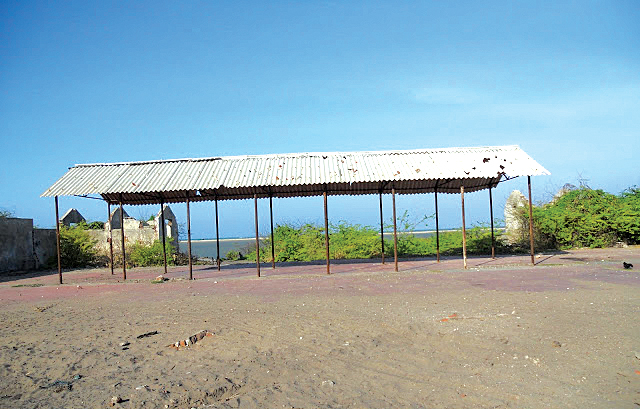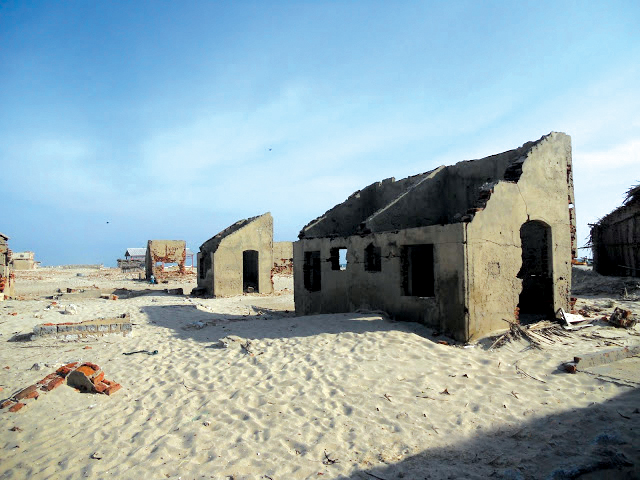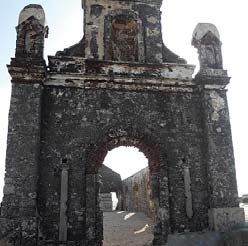Danushkodi memories
An article I recently read (below) reminded me of a trip we did in 2012 to the tip of Danushkodi – written by Walter Scott, no less! These are some pictures we took of that washed out old train station and other bits of destruction that still remain.
I have fond memories of the train stations of South India where I spent a lot of time. The Station Masters always fascinated me.
The language is so Indian. I especially liked the part where it says he "attained the age of superannuation" in 1991. I'm getting to that point myself.
It says he died of old age – nicely put. May we all go that way.
Editor's Note: The letter is from Dr. Ramu Sundaram who lives in the U.S. The article he refers to was a news item in The Hindu (probably only in the Madurai edition) by a reporter named D.J. Walter Scott. It was datelined Ramanathapuram, May 24, 2013 and was headlined: Last station master of Danushkodi passes away – Railway has lost one of its last living links to the 1964 tragedy.
* * *

Train station? |
'R. Sunderaraj, a railway officer who, unfazed, stood sentinel as Station Master in the Danushkodi Railway Station hours before the devastating cyclonic storm that destroyed the town on the night of December 22, 1964, passed away at the age of 80 in his home in K.K. Nagar, Madurai. With his death the Southern Railway has lost one of its last living links to the horrific tragedy that destroyed the railway station and washed away the incoming Train No.653, Pamban-Dhanushkodi Passenger, killing all 115 on board. Mr Sunderaraj was among the few on the island who survived the natural calamity and, as it turned out, was the last Station Master of Danushkodi Railway Station. After serving the day shift on December 22, 1964, he had returned home in the evening, little realising that it would be his last day at the station.
Recalling the nightmare and the most unforgettable moment of their lives, Mrs Gladys Sunderaraj said they were living in a house close to the shore, near a Church, when the cyclonic storm crashed into the tiny town.

Maybe, the offices at the station |
As they sat for dinner around 9 p.m., their five-year-old elder son looked terrified and refused to have dinner. He went to bed without eating, only to wake the family at half past midnight.
He looked terrified. There were gusty winds and her husband noticed water seeping into the house through the main door. He tried in vain to stop it by placing a gunny bag.
When he opened the door, water gushed into the house and soon things started floating. 'We left all our things and started walking towards the railway station, carrying our three children – a five-year-old son, a three-year-old daughter and a three-month-old daughter,' Mrs Sunderaraj recalled.
She said they walked for hours in neck-deep water, carrying their children on their shoulders and reached the railway station around 4.30 a.m. Only later, her husband came to know that train from Pamban was washed away on being hit by a huge tidal wave.

What remains of the church after the cyclone. |
(The tragedy came to light only after 48 hours when the railway headquarters issued a bulletin based on the information given by the Marine Superintendent, Mandapam.)
They stayed in the station for a week before they were shifted to Mandapam in a ship, she said. Their three-year-old daughter Shanthi, who fell sick during the tragedy, died after they moved to Tuticorin, she added.
Mr Sunderaraj was posted as Station Master in Danushkodi in November 1964 and had hardly served a month. He retired as the Senior Goods Supervisor in Tuticorin Railway Station when he attained the age of superannuation on May 31, 1991.'
(All pictures by Dr. Ramu Sundaram.)
A Nilgiris view
The three-part presentation on British interaction with the Nilgiris (MM, May-June, 2013) offers an interesting perspective. It is debatable how the English impact is still highlighted as the only worthy historical intervention in the livelihoods of the natives of the district. However, my intention here is not to pursue the matter, but only to offer some additional insight.
1. Leaving aside the "scant results" of Christian evangelism, the figure 4,000 mentioned for Christians in the Nilgiris must be attributed only to the Christian Badagas. I have, in one of my contributions to the encyclopedia, estimated, on available evidence, the total number of Christians in Nilgiris to be about 15 per cent of the population.
2. The London Missionary Society, as a denominational entity, never had any work in the Nilgiris. Their ecclesiastical structure was different from that of the Basal German Mission, Anglicans, Methodists and Catholics who were working during the British times. A full-fledged entry devoted to the history of Christianity in the Nilgiris is found in the encyclopedia.
3. There are surely more than 192 places that were given English names. Tamil names that have been foisted in present times are a legion more. The most unwarranted one is Udhagamandalam.
4. The alleged "intimate tie" of Col. Wellesley (later, Duke of Wellington) with the Nilgiris cannot be substantiated. He happened to be only one of the co-signatories of the Treaty that annexed the Nilgiris to the Madras domain of the East India Company in 1799.
He certainly did not fight for as long as several months in Nilgiri Wynaad nor was he the first of the British to have visited the hills, as stated in the write-up. The earliest English visitor to the hills (much before Sullivan) was Dr. Lacy Ford, an assistant surgeon of the Madras Medical Service in 1809, followed by Capt. Henry Bevan and William Morrison in 1812.
5. Col. Sartorius, Col. Stevenson and Col. Boles were the British officers who actually led the military expeditions against Pazhasi Raja (Pychey Rebel) in the Wynaad, portions of which were added to the Nilgiris only as late as in 1877. Col. Wellesley only headed the overall military operations from Srirangapatna in which capacity he happened to be the co-signatory of the Treaty, already mentioned. The experiences he derived mainly came from the strategies he directly employed against the Marathas and the Nizam on earlier occasions. To stretch them to Waterloo can only be a guess at its best.
6. Last but not the least, among so many others the following persons can also be accorded some place in the roll of honour. Dr. G.U. Pope (an award has since been instituted in his name by the Tamil Nadu Government) lived in Ooty between 1858 and 1871. He had his own fascinating ways in which he tried to make an impact. Incidentally, it was he who gave the name 'Snowdon' to a sacred Toda peak (ignoring its original name).
Then there was Margaret Cockburn of Kotagiri (1829-1928), a freelance ornithologist whose splendid collection of illustrations was published by the Natural History Museum of London in as recently as 2002. And who would like to forget Josiah Goodwin (d.1898), stenographer to Swami Vivekananda, resting in peace in the St. Thomas' churchyard in Ooty.
Rev. Philip K. Mulley
Anaihatti Road
Kotagiri 643 217
The Nilgiris
|